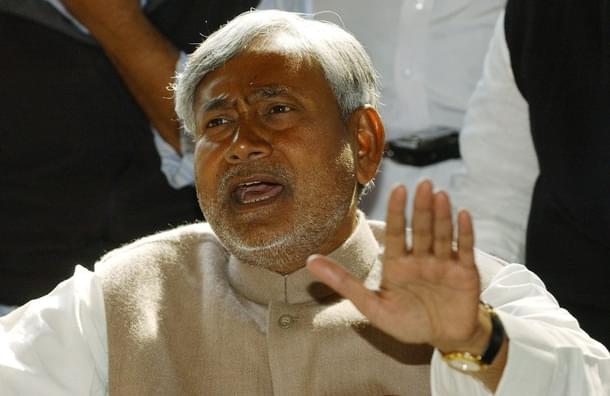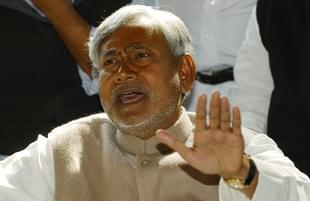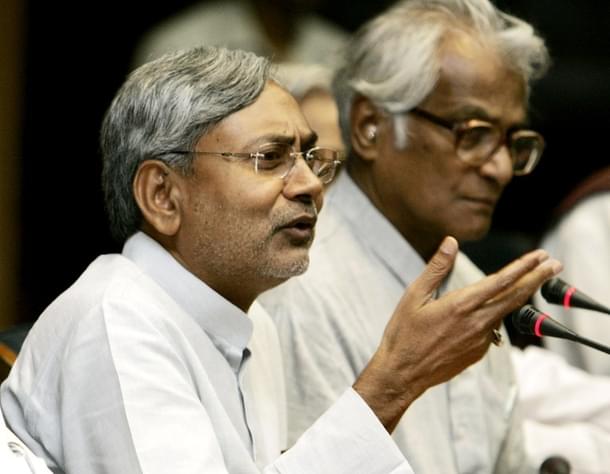Politics
Nitish Kumar: The Road to Political Death
Shwetank Bhushan Singh
Jun 13, 2015, 01:45 PM | Updated Feb 11, 2016, 10:12 AM IST
Save & read from anywhere!
Bookmark stories for easy access on any device or the Swarajya app.


Most ambition-driven journeys remain incomplete. But, Nitish Kumar’s has been a fascinating one with many more ups than downs. Son of a Congress-reject candidate, young Nitish joined active state politics in Bihar in 1974. Like many others, he too was inspired by the imposing stature of Loknayak Jayaprakash Narayan, which motivated him to play an important role in the JP movement. Kumar belongs to the socialist class of politicians, who learned their political lessons from veterans like Jayaprakash Narayan, Ram Manohar Lohia, Karpoori Thakur, George Fernandes, Satyendra Narayan Sinha and former Prime Minister V P Singh, who challenged the hegemony of the Congress party.
The state assembly elections in 1980 saw him take a small step forward in his political career. Caste being a significant determinant of outcomes in Bihar at that time, Nitish contested from his native Harnaut, Nalanda, which had a strong presence of his fellow Kurmis. But he lost. In 1985, he was first elected to the Bihar Legislative Assembly as an independent candidate. After this win, there was no looking back.
In 1987, he became the President of the Yuva Lok Dal. Two years later, he became active in national politics after becoming the General Secretary of Janata Dal that had been formed under V P Singh’s leadership to challenge the corruption-struck Rajiv Gandhi-led Congress party. Nitish represented Barh Lok Sabha constituency (a sub-division of Patna District). In 1989, he was made agriculture minister in V P Singh’s government. In 1991, he was re-elected to the Lok Sabha and nominated as the deputy leader of the Janata Dal in the Parliament. From 1989 to 1994, he was part of different governments at the centre.
Nitish was very close to Lalu Yadav, then Chief Minister of Bihar. During Lalu’s regime in the early 90s, anarchy ruled the state. Dominance of Yadavs and suppression of upper castes as the primary political objective walked hand in hand. In 1992, Lalu’s notorious proclamation defined what he had set out to do, “Bhura baal saaf karo (eliminate Bhumihars, Brahmins, Rajputs, Lalas or Kayasthas).” Realising that any opposition to Lalu will be futile, Nitish decided to move on in a separate direction.
The career graph of Nitish shows that he has been a risk taker, who bides his time and waits for the right opportunity to come along. Indeed, his opportunism has frequently surfaced during his political journey. Back then, however, without his revolt, there would have been no end to the jungle raj that had been unleashed in the state in the 1990s.
Challenging Yadav dominance in backward class politics, Nitish broke away from the erstwhile Janata Dal (JD) in 1994, with his OBC (Kurmi and Koeri) caste supporters. Along with George Fernandes, he formed the Samata Party. The proximity shared by Lalu and Nitish made way for bitterness. After launching their own parties, they fiercely fought against each other in every election in Bihar.

From 1997 to 2010, Nitish led a campaign against the malpractices of Lalu government, especially focussing on the infamous fodder scam and the high crime rates in the state. Nitish also accused Lalu of being the “most communal” leader the state had ever witnessed, charging him of saving perpetrators of Bhagalpur Riots of 1989. Eventually, the Samata Party lost convincingly in the 1995 legislative elections.
What is well known is that Nitish almost begged his mentor George Fernandes to forge an alliance with the BJP during the 1996 general elections. Fernandes and senior BJP leaders Atal Bihari Vajpayee and L.K. Advani began to interact at the political level, resulting in ties between the former socialists and the BJP. It deepened in 1996 after the BJP emerged as the single largest party in the country and the second largest party in Bihar. The National Democratic Alliance (NDA) was formed in 1998. In 1999, when Jharkhand hadn’t been carved out of Bihar, NDA secured 41 out of 51 seats in the state.
Janata Dal suffered a nationwide debacle. Lalu quit Janata Dal, floated Rashtriya Janta Dal (RJD) and bounced back in the 2000 assembly polls, albeit with a reduced vote share. RJD won 124 seats, and NDA won 108. But it took the tally to 125 with help from other allies. However, the NDA could not muster the numbers required to form the government, and Nitish had to resign from his Chief Ministership a week after assuming office. With the support of the Congress, Rabri Devi took charge of Bihar.
As the crisis within the Janata Dal deepened, the Sharad Yadav faction of JD, along with Ram Vilas Paswan’s Lokshakti Party, merged with the Samata Party. This led to the birth of the Janata Dal (United) within the NDA on October 30, 2003. Nitish Kumar continued to serve as the Union Minister for Railways in the NDA regime.
In August 1999, he had resigned following the Gaisal train disaster on moral grounds, eyeing the 2000 state elections. During his term as Railways Minister in Atal Bihari Vajpayee’s cabinet, he introduced widespread reforms, such as internet ticket booking facility, opening a record number of railway ticket booking counters and introducing the revolutionary ‘tatkal scheme’ for instant booking.
The infamous burning of passengers by a Muslim mob at Godhra, followed by the Godhra riots of 2002, took place during his tenure. This was also the time when Narendra Modi had been newly appointed as the Chief Minister of Gujarat. This time, however, Kumar didn’t repeat what he had done earlier: which is, resign on moral grounds. With the alliance making progress in Bihar, he continued to hold on to his portfolio.
Even when the entire opposition to BJP was busy attacking Modi with all kinds of allegations in the post-riot environment, Nitish, in a public meeting in Gujarat, hailed Modi and urged the masses to leave the unfortunate incident behind. Not only that, he actually emphasised that Modi was not going to be restricted only to Gujarat, and, that one day, he will serve India for a larger cause. Such was his foresightedness.
https://www.youtube.com/watch?v=8L261KncPd4
In the parliamentary elections of 2004, JD(U) contested the elections as a core ally of the NDA. Nitish Kumar contested from Nalanda and Barh, two separate constituencies. He won the Nalanda seat, but could not win from Barh, his conventional stronghold. However, he was nominated as the floor leader of the JD(U) in the Parliament.
In the meantime, Fernandes (mentor of Nitish and the chief architect of Samata Party and the NDA’s triumph over Lalu raj) was swiftly cornered by Nitish. Sources confirm that he was becoming a hindrance to Nitish’s autocratic style of functioning. In a 2009 letter to old socialist associate Kumar Aurangabadkar, Fernandes wrote: “What you mention about Nitish is correct. I brought that fellow but he went on to see that I am sidelined.” Further research yields another letter which Fernandes wrote to JD(U) president Sharad Yadav about his desire to contest the Lok Sabha elections from Muzaffarpur because “as a socialist, I am against entering Rajya Sabha.” Nitish was undeterred.
The watershed event in Bihar’s politics came in the 2005 state assembly polls, when the NDA first tasted power in the state. They swept the polls, crushing the Congress and eclipsing Lalu’s RJD. It was the first time since the late 80s that Bihar voters chose development over identity politics. With the voters thinking along those lines, be it for legislative assembly or the Parliamentary election, Nitish became the Chief Minister of Bihar and crafted the idea of good governance. In 2005, the jungle raj in the state came to an end.
Nitish Kumar received praises from several quarters, and all opinion polls suggested a clean sweep for the NDA in Bihar under Nitish’s leadership. He was fondly called ‘Sushasan Babu’ by his fans and followers in Bihar. Nitish’s mission was clear. He wanted to decimate Lalu in the state, and emerge as a potential prime ministerial candidate of NDA or any other alliance in future. Believing that this was possible only if Lalu lost control over his Muslim vote bank, he distanced himself from Modi who was being continuously criticised by the so-called secular parties and a large section of the mainstream media. Nitish, on the other hand, was trying to market his secular credentials by wearing skull caps.
In June, 2010, a few days before the BJP’s national executive was to meet in Patna, posters began to appear on the city’s walls thanking Modi for his noble donation towards relief for Kosi flood victims: a sum of Rs 5 crore. When the BJP session began, Nitish was not in Patna. He was in north Bihar on his Vikas Yatra, laying the ground for assembly elections. He was returning, though, having ensured Sushil Modi of the BJP (then deputy chief minister) that he would host a dinner for the BJP leaders before they left Patna.
In his book on Nitish Kumar, journalist Sankarshan Thakur writes that when Nitish saw the ‘morning papers” the following day, he was so incensed that he “couldn’t hold his cup of tea straight.” Sponsored by local leaders and some Gujarat NGOs were two full-page advertisements in “Patna’s largest circulated Hindi dailies,” which thanked Modi for the money for relief. He wasn’t concerned about the “text,” “it was the subtext that burned into Nitish – the Ludhiana photograph leapt off the page: there it was again, Narendra Modi and Nitish Kumar, palms clutched and held aloft…Nitish thought it was distasteful and offensive taunt; a makhaul, mockery….”
Angry and not at all keen to conceal it, Nitish called off the dinner. Sushil Modi tried reasoning with him through intermediaries, but in vain. This will send out a wrong message before the elections, he was told. But, a curt Nitish didn’t change his stance. A wrong message had already been sent. How did the advertisements get published without his knowledge, he asked.
Gloom descended on the BJP camp. Many top leaders, including then party chief Nitin Gadkari, L K Advani and Arun Jaitley, sensed that Modi had caused unnecessary provocation and given the alliance, a serious jolt. They had lost to the Congress at the Centre for the second successive time in 2009. The contempt for Modi in public could rob them of another key state. Meanwhile, Modi failed to understand what the fuss over the advertisement was all about. He complained about his rude behaviour, which had led to the withdrawal of a dinner invitation. He asked why he should not be welcome in an NDA-ruled state, and affirmed that it was high time these questions were asked.
Addressing a party rally in Patna’s Gandhi Maidan the next day, he asked Bihar’s residents to visit Gujarat and see how the state had prospered. He was putting Nitish down. He concluded his speech without naming him..
Incidentally, in 2010, the remarkable aspect of NDA’s win was the scale: 206 seats in the 243 strong House. JD (U) alone bagged 115 seats, while its ally BJP also turned in a stunning performance, winning 91 seats of 102 seats contested.
For Lalu, two consecutive defeats implied a powerless existence at the Centre and also in Bihar, where he was once the darling of the dispossessed. More importantly, Bihar had dealt a knockout punch to Congress’s plans for a revival and exposed the limits of Rahul Gandhi’s appeal. Five years ago, the party had contested in 51 seats, and won nine of them. This time, it contested in all the 243 seats but managed to send only four winners to the assembly.
Since 2005, the NDA remained in power until Nitish, an ambitious Chief Minister, finally pulled the plug. His decision to break away from the BJP proved to be a stupendous mistake, and this was clearly seen when he resigned from the post of CM immediately after the BJP swept the national elections. But even when he resigned, he was eyeing the future. The strategist in him thought that he could be a part of the decision-making process even if he was not the chief minister through a chief minister who was his own man. With his game plan in mind, he chose Jitan Ram Manjhi, a man from an extremely backward caste, for the CM’s job. The move backfired.
When Lalu was convicted in the fodder scam, Nitish naturally welcomed it. Lalu, in his petition, alleged that trial court judge was biased against him under influence of Nitish, “who is his (Yadav”s) biggest political enemy.” The situation now is different, but very clear. Two fierce enemies have come together, in spite of so much animosity and rivalry between the two.
Assuming that a merger would ensure that the vote share would be fully transferable based on simple mathematics would be foolish. The reason: it is important to understand that the core voters of both Lalu and Nitish are more or less nontransferable. Both Yadavs and Kurmis have been fighting against each other on the ground for the last two decades. Besides, Lalu is a ruthlessly shrewd politician, and he has every reason to hate Nitish on a personal basis, the latter having done more than enough to have him exiled from the political stage.
From the looks of it, it does seem that the merger will result in the revival of Lalu. In spite of what the psephologists and many political pundits have been saying, Nitish, having dug his own grave, is walking towards an immediate political death.
Business strategist. Painter, random blogger, movie buff. Interested in Indian history





